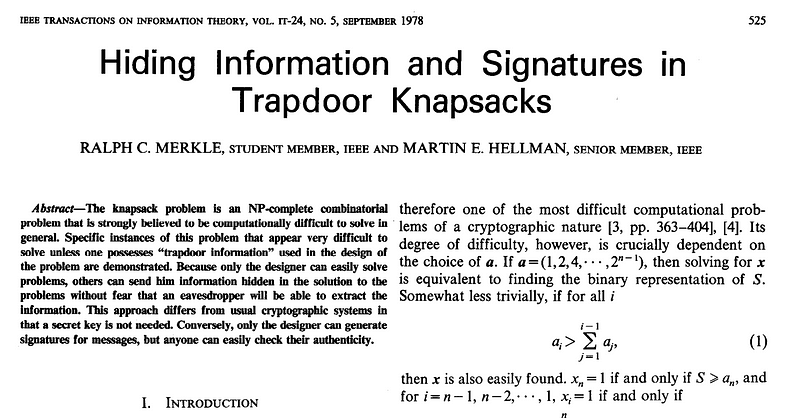Pack Your Knapsack For Some Secret Messages — Difficult to Pack/Easy to Unpack

Pack Your Knapsack For Some Secret Messages — Difficult to Pack/Easy to Unpack
RSA is just one way of doing public key encryption. Knapsack is a good alternative where we can create a public key and a private one:

The knapsack problem defines a problem where we have a number of weights and then must pack our knapsack with the minimum number of weights that will make it a given weight. In general, the problem is:
- Given a set of numbers A and a number b.
- Find a subset of A which sums to b (or gets nearest to it).
So imagine you have a set of weights of 1, 4, 6, 8 and 15, and we want to get a weight of 28, we could thus use 1, 4, 8 and 15 (1+4+8+15=28).
So our code would become 11011 (represented by ‘1’, ‘4’, no ‘6’, ‘8’ and ‘15’).
Then if our plain text is 11011, with a knapsack of 1, 4, 6, 8, 15, we have a cipher text of 1+4+8+15 which gives us 28.
A plain text of 00001 will give us a cipher text of 15.
With public key cryptography, we have two knapsack problems. One of which is easy to solve (private key), and the other difficult (public key).
Creating a public and a private key
We can now create a superincreasing sequence with our weights where the current value is greater than the sum of the preceding ones, such as {1, 2, 4, 9, 20, 38}. Superincreasing sequences make it easy to solve the knapsack problem, where we take the total weight, and compare it with the largest weight, if it is greater than the weight, it is in it, otherwise, it is not.
For example with weights of {1,2,4,9,20,38} with a value of 54, we get:
Check 54 for 38? Yes (smaller than 54). [1] We now have a balance of 16.
Check 16 for 20? No. [0].
Check 16 for 9? Yes. [1]. We now have a balance of 5.
Check 5 for 4? Yes. [1]. We now have a balance of 1.
Check 1 for 2? No. [0].
Check 1 for 1? Yes [1].
Our result is 101101.
If we have a non-superincreasing knapsack such as {1,3,4,6,10,12,41}, and have to make 54, it is much more difficult. So a non-superincreasing knapsack can be the public key, and the superincreasing one is the private key.
Making the Public Key
We first start with our superincreasing sequence, such as {1,2,4,10,20,40} and take the values and multiply by a number n, and take a modulus (m) of a value which is greater than the total (m — such as 120). For n we make sure that there are no common factors with any of the numbers. Let’s select an n value of 53, so we get:
1×53 mod(120) = 53
2×53 mod(120) = 106
4×53 mod(120) = 92
10×53 mod(120) = 50
20×53 mod(120) = 100
40×53 mod(120) = 80
So the public key is: {53,106,92,50,100,80} and the private key is {1, 2, 4, 10, 20,40}. The public key will be difficult to factor while the private key will be easy.
Let’s try to send a message that is in binary code:
111010 101101 111001
We have six weights so we split into three groups of six weights:
111010=53 + 106 + 92 + 100 = 351
101101 = 53+92+50+80 = 275
111001 = 53 + 106 + 92 + 80 = 331
Our cipher text is thus 351 275 331.
The two numbers known by the receiver is thus 120 (m — modulus) and 53 (n multiplier).
We need n^(−1), which is a multiplicative inverse of n mod m, i.e. n(n−1) = 1 mod m. For this we find the inverse of n (_n):
_n = 53^(-1) mod 120
(53 x _n) mod 120 = 1
So we try values of _n in (53 x _n mod 120) in order to get a result of 1:
So the inverse is 77 [Calculator].
The coded message is 351 275 331 and is now easy to calculate the plain text:
351×77 mod(120) = 27 = 111010 (1+2+4+20)
275×77 mod(120) = 55 = 101101
331×77 mod(120) = 47 = 111001
The decoded message is thus:
111010 101101 110001
which is the same as our original message:
111010 101101 111001
The decoding was so easy, the only thing we had was to find the inverse which is not too difficult.
Try this example here.
On this Wiki page [Here], the private key is {2, 7, 11, 21, 42, 89, 180, 354}, n=792, m=881, with data of “01100001” which gives a public key of {295, 592, 301, 14, 28, 353, 120, 236} and gives a cipher of “1129”. Try example here.
Conclusion
Knapsack encryption provides a good approach to creating public and private keys, where their private key is easy to use, while the public key is difficult to compute. The method was outlined by Ralph Merkle in his search for a trap door function [1], but the glory of the sustainable trap door went to RSA, and soon cracks began to show when Adi Shamir [2] published methods to crack it:

References
[1] Merkle, Ralph; Hellman, Martin (1978). “Hiding information and signatures in trapdoor knapsacks”. Information Theory, IEEE Transactions on 24 (5): 525–530. doi:10.1109/TIT.1978.1055927.
[2] Shamir, Adi (1984). “A polynomial-time algorithm for breaking the basic Merkle — Hellman cryptosystem”. Information Theory, IEEE Transactions on 30 (5): 699–704. doi:10.1109/SFCS.1982.5.